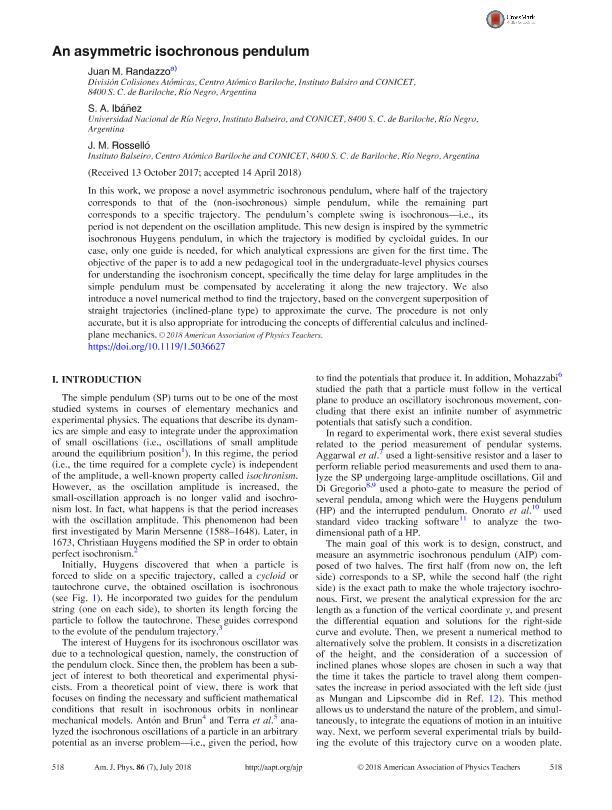Mostrar el registro sencillo del ítem
dc.contributor.author
Randazzo, Juan Martin

dc.contributor.author
Ibáñez, Santiago Agustín

dc.contributor.author
Rosselló, Juan Manuel

dc.date.available
2020-08-25T14:48:33Z
dc.date.issued
2018-07
dc.identifier.citation
Randazzo, Juan Martin; Ibáñez, Santiago Agustín; Rosselló, Juan Manuel; An asymmetric isochronous pendulum; American Association of Physics Teachers; American Journal of Physics; 86; 7; 7-2018; 518-525
dc.identifier.issn
0002-9505
dc.identifier.uri
http://hdl.handle.net/11336/112307
dc.description.abstract
In this work, we propose a novel asymmetric isochronous pendulum, where half of the trajectory corresponds to that of the (non-isochronous) simple pendulum, while the remaining part corresponds to a specific trajectory. The pendulum’s complete swing is isochronous—i.e., its period is not dependent on the oscillation amplitude. This new design is inspired by the symmetric isochronous Huygens pendulum, in which the trajectory is modified by cycloidal guides. In our case, only one guide is needed, for which analytical expressions are given for the first time. The objective of the paper is to add a new pedagogical tool in the undergraduate-level physics courses for understanding the isochronism concept, specifically the time delay for large amplitudes in the simple pendulum must be compensated by accelerating it along the new trajectory. We also introduce a novel numerical method to find the trajectory, based on the convergent superposition of straight trajectories (inclined-plane type) to approximate the curve. The procedure is not only accurate, but it is also appropriate for introducing the concepts of differential calculus and inclinedplane mechanics.
dc.format
application/pdf
dc.language.iso
eng
dc.publisher
American Association of Physics Teachers

dc.rights
info:eu-repo/semantics/openAccess
dc.rights.uri
https://creativecommons.org/licenses/by-nc-sa/2.5/ar/
dc.subject
HUYGENS PENDULUM
dc.subject
ISOCHRONOUS PENDULUM
dc.subject
ANALYTIC SOLUTION
dc.subject
ASYMETRIC PENDULUM
dc.subject.classification
Otras Ciencias Físicas

dc.subject.classification
Ciencias Físicas

dc.subject.classification
CIENCIAS NATURALES Y EXACTAS

dc.title
An asymmetric isochronous pendulum
dc.type
info:eu-repo/semantics/article
dc.type
info:ar-repo/semantics/artículo
dc.type
info:eu-repo/semantics/publishedVersion
dc.date.updated
2019-10-15T17:57:28Z
dc.journal.volume
86
dc.journal.number
7
dc.journal.pagination
518-525
dc.journal.pais
Estados Unidos

dc.journal.ciudad
New York
dc.description.fil
Fil: Randazzo, Juan Martin. Comisión Nacional de Energía Atómica. Gerencia del Área de Energía Nuclear. Instituto Balseiro; Argentina. Consejo Nacional de Investigaciones Científicas y Técnicas. Centro Científico Tecnológico Conicet - Patagonia Norte; Argentina. Comisión Nacional de Energía Atómica. Centro Atómico Bariloche; Argentina
dc.description.fil
Fil: Ibáñez, Santiago Agustín. Comisión Nacional de Energía Atómica. Gerencia del Área de Energía Nuclear. Instituto Balseiro; Argentina. Universidad Nacional de Río Negro; Argentina. Consejo Nacional de Investigaciones Científicas y Técnicas. Centro Científico Tecnológico Conicet - Patagonia Norte; Argentina
dc.description.fil
Fil: Rosselló, Juan Manuel. Comisión Nacional de Energía Atómica. Gerencia del Área de Energía Nuclear. Instituto Balseiro; Argentina. Consejo Nacional de Investigaciones Científicas y Técnicas. Centro Científico Tecnológico Conicet - Patagonia Norte; Argentina. Comisión Nacional de Energía Atómica. Centro Atómico Bariloche; Argentina
dc.journal.title
American Journal of Physics

dc.relation.alternativeid
info:eu-repo/semantics/altIdentifier/url/http://aapt.scitation.org/doi/10.1119/1.5036627
dc.relation.alternativeid
info:eu-repo/semantics/altIdentifier/doi/http://dx.doi.org/10.1119/1.5036627
Archivos asociados
